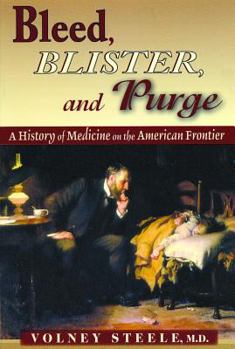Bleed, Blister, and Purge: A History of Medicine on the American Frontier
Select Format
Select Condition 
Book Overview
Bleed, Blister, and Purge traces the fits and starts of medical progress on the western frontier. With the authority of a scholar and the sparkle of an old-time storyteller, Dr. Volney Steele takes the reader from rotgut whiskey to modern anesthetics, from castor oil to antibiotics, and from barroom surgery to modern hospital operations.
Dr. Steele wrote Bleed, Blister, and Purge "to shed light on and celebrate the dedication and...
Format:Paperback
Language:English
ISBN:0878425055
ISBN13:9780878425051
Release Date:June 2005
Publisher:Mountain Press Publishing Company
Length:367 Pages
Weight:1.35 lbs.
Dimensions:1.1" x 6.5" x 9.0"
Customer Reviews
5 ratings
A truly wonderful book
Published by Thriftbooks.com User , 14 years ago
wow where do i start with such a wondrous and informative book Such as this. I was skeptical when i brought it after reading some of the reviews here, but these people either need to learn how to read a glossary of terms, or read a childrens book on basic medical conditions. like with most scholarly texts, it is required to have some previous knowledge of medicine, but anybody who has taken an interest in history, or even their own physical health will have no problem knowing terms and understanding treatments. As the Author of this book is elderly, i can feel through the pages the depth of character and spirituality within, that this work is his final goodbye to his profession. It feels like a private prayer he is conveying to his ancestors and i truly feel privileged to have the ability to read it. Buy this book, respect the wealth of information provided, and share in the privilege of this spiritual homage.
Excellent Resource
Published by Thriftbooks.com User , 14 years ago
Well organized, informative, interesting and entertaining. From the descriptions and technical details to the biographical sketches and illustrations, Bleed, Blister and Purge is an invaluable resource for those researching medicine on the American frontier.
Bleed, Blister and Purge: A History of Medicine on the American Frontier
Published by Thriftbooks.com User , 17 years ago
A must read for any re-enactor. Wonderful look at frontier medicine in the 1800s and early 1900s.
Interesting anecdotal history of frontier medicine
Published by Thriftbooks.com User , 18 years ago
In the first part of this book, Steele covers a wide range of topics, from native medicine to Lewis & Clark to folk medicine, quackery, and the pioneering physicians who first came to the West. A section on women physicians is both inspiring and troubling: one admires the women who defied convention to become doctors, but shudders at the stories of women's health in the era and how poorly understood were needs such as prenatal care and birth control. In the second section, Steele talks about public health, including early hospitals, sanitation, and epidemic disease. Again, with a good eye for telling details, stories, and photographs, Steele reveals an unfamiliar story with what he calls a "mixture of awe and distress." I've always been interested in epidemics, and found particular fascination in the discussion of the frightening diseases that stalked the frontier, especially the resistance of civic leaders and ordinary citizens to take the appropriate measures to stop them. Many families lost children to cholera, diphtheria, and other so-called "childhood diseases" before understanding and civic will brought about changes in sanitation. Cattle ranchers initially fought the tick-control efforts to curb Rocky Mountain spotted fever and the veterinary procedures to eradicate typhoid and bovine tuberculosis. Even during the flu pandemic of 1918, which killed an astonishing 675,000 Americans, people resisted all efforts to curb public gatherings to try to stop the spread of the disease. But it was the story of polio that most surprised me. Beginning in 1916, a series of polio epidemics terrified the nation almost every summer. Polio was worse in rural areas such as Montana and other western states, where children had not built up the viral resistance that saved many children in more densely populated areas. Steele notes that the fear of polio took on a life of its own, out of all proportion to the actual risk of the disease. Out of millions infected with polio, only one percent became paralyzed; half of these children later regained normal function. The rest recovered with no lasting harm. From the 1920s to the 1940s, children were five to ten times more likely to catch diphtheria, tuberculosis, scarlet fever, or strep throat than polio, any one of which had a higher death rate. But the fear of paralysis, however unlikely, made polio the most haunting and feared of all infectious diseases. The reason isn't hard to understand. In those years, disabled children were barred from attending school. In some places they were not allowed out in public, and faced ridicule and ostracism if they did go out. Worst of all, they became a burden on their families. In a time and place where most work was physical, a disabled person was a real drain on the ability of a farm or ranch family to survive. Becoming crippled was truly a fate worse than death. It's interesting to wonder what attitudes now drive our fears and how they will look to generations ye
Concise and well written
Published by Thriftbooks.com User , 19 years ago
This book refers to the 1800s in Montana through the eyes of various doctors and medical personnel. Well written and filled with interesting facts from the era. An excellent read and well worth your time. If you are studying medicine in the Old West, this is the book for you.





